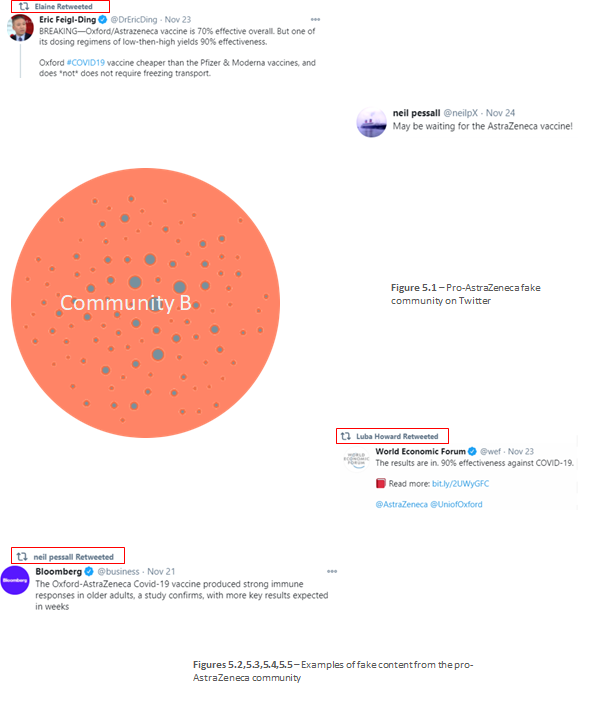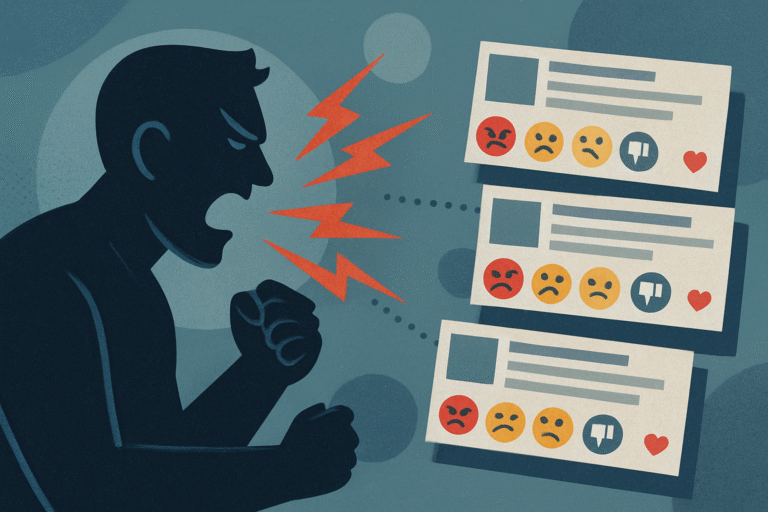With COVID-19 vaccines currently being developed and deployed worldwide, the public now faces its next public health challenge- that of disinformation.
In efforts to shed light on some of the ongoing fake campaigns circulating on social media, Cyabra used its AI based solution to scan these conversations to gain a deeper understanding of these campaigns. Focusing on Facebook and Twitter, Cyabra analyzed the online behavior, connections, and messaging of 132,000 profiles. Here, we found nearly 18,000 fake profiles (13.5%). Based on Cyabra’s experience with disinformation campaigns, this percentage of fake profiles indicates the presence of an online disinformation campaign. Cyabra typically encounters around seven to ten percent of fake profiles.
Findings
Cyabra’s tools analyze the connections between each profile in order to understand the impact and reach of each profile. The image below is a cluster from Cyabra’s dashboard representing the main profiles participating in the vaccines discourse on Twitter and the manner in which they are connected. The red nodes represent fake profiles; the green nodes represent real profiles. The bigger the node, the more connections the profile has.

While the visual link analysis depicted above shows all of the profiles that interacted with one another (following, replying, or retweeting), the images below represent segmented profiles, otherwise known as “communities.” Cyabra’s “community” function highlights profiles that are highly engaged with each other and share the greatest number of connections and, often, a common theme. The themes that Cyabra uncovered relating to COVID-19 vaccines are presented in the images below. Analyzing all of the fake profiles, Cyabra discovered three Twitter communities comprised of fake profiles tweeting three distinctive sets of messaging. Two of these fake campaigns actively spread favorable tweets about AstraZeneca’s vaccine while criticizing other companies developing vaccines. The third fake campaign disputes the existence of COVID-19 and attacks the utility of all COVID-19 vaccines.

Community A: Anti-Vaccine
The anti-vaccine community contains 136 fake profiles that are actively spreading negative content against all COVID-19 vaccines.

Community B: Pro-AstraZeneca (1)
Community B contains 239 fake profiles circulating positive content about AstraZeneca’s vaccine progress and positive content about the company.

Community C: Pro-AstraZeneca (2)
Community C also praises AstraZeneca but spreads harmful content surrounding Pfizer’s COVID-19 vaccine. This community contains 220 fake profiles.

Cyabra did not find a significant difference on Facebook between topics discussed by real profiles and the ones discussed by fake profiles. However, a trending topic that stood out amongst fake Facebook participating in the COVID-19 vaccine discourse was Bitcoin. The image below represents an example of the system’s classification of subjects, with subjects used by real profiles shown in green and ones used by fake profiles shown in red.

While the real profiles did not discuss anything relating to Bitcoin, fake profiles used the subject of Bitcoin numerous times. Cyabra analysts found that these fake profiles spread content on Bitcoin for advertising as a part of a fake campaign.
Below is an image from Cyabra’s platform showing the connections between the fake profiles on Facebook that posted about Bitcoin in discussions relating to COVID-19 vaccines. The fake campaign is taking advantage of the online interest in COVID-19 vaccines to promote a Bitcoin website. The fake profiles identified posts related to COVID-19 vaccines with high engagement and replied to them with promotional content about Bitcoin sites and Telegram groups.

Aside from communities, there is also merit to doing a deep dive of the most influential profiles. In a disinformation campaign, there are typically three types of profiles with the highest impact in a fake campaign: 1.The most content: The more posts, replies and shares a profile creates, the more influence it has in shaping the conversation, both within the campaign and with profiles that are only partially connected to the campaign. 2.The most connections: The more connections a profile has, the more it can control what people within the campaign see. 3.The most engaged: Profiles that are the most active in a campaign can shape the way people who are new to the subject perceive it.
Cyabra marks the connections between fake and real profiles to emphasize which fake accounts “break through” the fake profile sphere and can influence real profiles. Understanding which fake profiles have the highest number of real connections is another method to understand which fake profile has the most influence.
The most connected fake profile on Twitter is esme_hornbeam, with 63 fake connections. The system labeled the profile as fake due to a large percentage of its content being retweets, and its bot-oriented behavior. To identify any content possibly linked to the subject, Cyabra extracted multiple tweets that the profile tweeted about the COVID-19 vaccines.


Conclusion
With COVID-19 vaccines currently being developed and deployed worldwide, the public now faces its next public health challenge- that of disinformation. In efforts to shed light on some of the ongoing fake campaigns circulating on social media, Cyabra scanned 132,000 accounts where advanced AI uncovered multiple, harmful agendas. Within this sample, 18,000 profiles were fake, resulting in a significant reach of each of these disinformation campaigns. With two of the fake Twitter campaigns favoring the AstraZeneca COVID-19 vaccine, the misleading agenda intended to promote the vaccine as superior to the other COVID-19 vaccines in development. The third Twitter disinformation campaign, and perhaps the most dangerous, attacked the existence of the Coronavirus and all COVID-19 vaccines, claiming that the Coronavirus does not exist and is a guise by governments planning to control human actions. Additionally, Cyabra identified another campaign of fake profiles on Facebook that exploited the online interest in COVID-19 to advertise Bitcoin.
As disinformation becomes a more prevalent threat, Cyabra continues to monitor the disinformation surrounding COVID-19.


